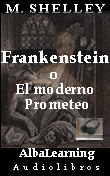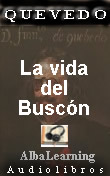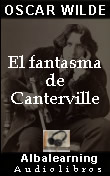|
|
|
|
| | HOME | AUDIOLIBROS | AMOR | ERÓTICA | HUMOR | INFANTIL | MISTERIO | POESÍA | NO FICCIÓN | BILINGUAL | VIDEOLIBROS | NOVEDADES | | |||||||||||||||
|
|
|
|
|||||||||||||
|
|||||||||||||||
|
"El retrato oval - The oval portrait" |
||||||
Biografía de Edgar Allan Poe en Wikipedia |
||||||
|
||||||
| EL RETRATO OVAL |
||||||
EL RETRATO OVAL
| ||
| Double-click on any word!! | ||
|
[ Descargar archivo mp3 ] 13:55
|
(Haga doble clic en la palabra deseada en Inglés para saber su significado y pronunciación) | |
EL RETRATO OVAL
| THE OVAL PORTRAIT
| |
El castillo al cual mi criado se había atrevido a entrar por la fuerza antes de permitir que, gravemente herido como estaba, pasara yo la noche al aire libre, era una de esas construcciones en las que se mezclan la lobreguez y la grandeza, y que durante largo tiempo se han alzado cejijuntas en los Apeninos, tan ciertas en la realidad como en la imaginación de Mrs. Radcliffe. Según toda apariencia, el castillo había sido recién abandonado, aunque temporalmente. Nos instalamos en uno de los aposentos más pequeños y menos suntuosos. Hallábase en una apartada torre del edificio; sus decoraciones eran ricas, pero ajadas y viejas. Colgaban tapices de las paredes, que engalanaban cantidad y variedad de trofeos heráldicos, así como un número insólitamente grande de vivaces pinturas modernas en marcos con arabescos de oro. Aquellas pinturas, no solamente emplazadas a lo largo de las paredes sino en diversos nichos que la extraña arquitectura del castillo exigía, despertaron profundamente mi interés, quizá a causa de mi incipiente delirio; ordené, por tanto, a Pedro que cerrara las pesadas persianas del aposento —pues era ya de noche—, que encendiera las bujías de un alto candelabro situado a la cabecera de mi lecho y descorriera de par en par las orladas cortinas de terciopelo negro que envolvían la cama. Al hacerlo así deseaba entregarme, si no al sueño, por lo menos a la alternada contemplación de las pinturas y al examen de un pequeño volumen que habíamos encontrado sobre la almohada y que contenía la descripción y la crítica de aquéllas.
| The chateau into which my valet had ventured to make forcible entrance, rather than permit me, in my desperately wounded condition, to pass a night in the open air, was one of those piles of commingled gloom and grandeur which have so long frowned among the Apennines, not less in fact than in the fancy of Mrs. Radcliffe. To all appearance it had been temporarily and very lately abandoned. We established ourselves in one of the smallest and least sumptuously furnished apartments. It lay in a remote turret of the building. Its decorations were rich, yet tattered and antique. Its walls were hung with tapestry and bedecked with manifold and multiform armorial trophies, together with an unusually great number of very spirited modern paintings in frames of rich golden arabesque. In these paintings, which depended from the walls not only in their main surfaces, but in very many nooks which the bizarre architecture of the chateau rendered necessary--in these paintings my incipient delirium, perhaps, had caused me to take deep interest; so that I bade Pedro to close the heavy shutters of the room--since it was already night--to light the tongues of a tall candelabrum which stood by the head of my bed--and to throw open far and wide the fringed curtains of black velvet which enveloped the bed itself. I wished all this done that I might resign myself, if not to sleep, at least alternately to the contemplation of these pictures, and the perusal of a small volume which had been found upon the pillow, and which purported to criticise and describe them.
| |
Mucho, mucho leí... e intensa, intensamente miré. Rápidas y brillantes volaron las horas, hasta llegar la profunda medianoche. La posición del candelabro me molestaba, pero, para no incomodar a mi amodorrado sirviente, alargué con dificultad la mano y lo coloqué de manera que su luz cayera directamente sobre el libro.
|
Long--long I read--and devoutly, devotedly I gazed. Rapidly and gloriously the hours flew by, and the deep midnight came. The position of the candelabrum displeased me, and outreaching my hand with difficulty, rather than disturb my slumbering valet, I placed it so as to throw its rays more fully upon the book. |
|
El cambio, sin embargo, produjo un efecto por completo inesperado. Los rayos de las numerosas bujías (pues eran muchas) cayeron en un nicho del aposento que una de las columnas del lecho había mantenido hasta ese momento en la más profunda sombra. Pude ver así, vívidamente, una pintura que me había pasado inadvertida. Era el retrato de una joven que empezaba ya a ser mujer. Miré presurosamente su retrato, y cerré los ojos. Al principio no alcancé a comprender por qué lo había hecho. Pero mientras mis párpados continuaban cerrados, cruzó por mi mente la razón de mi conducta. Era un movimiento impulsivo a fin de ganar tiempo para pensar, para asegurarme de que mi visión no me había engañado, para calmar y someter mi fantasía antes de otra contemplación más serena y más segura. Instantes después volví a mirar fijamente la pintura. |
But the action produced an effect altogether unanticipated. The rays of the numerous candles (for there were many) now fell within a niche of the room which had hitherto been thrown into deep shade by one of the bed-posts. I thus saw in vivid light a picture all unnoticed before. It was the portrait of a young girl just ripening into womanhood. I glanced at the painting hurriedly, and then closed my eyes. Why I did this was not at first apparent even to my own perception. But while my lids remained thus shut, I ran over in mind my reason for so shutting them. It was an impulsive movement to gain time for thought--to make sure that my vision had not deceived me--to calm and subdue my fancy for a more sober and more certain gaze. In a very few moments I again looked fixedly at the painting. |
|
Ya no podía ni quería dudar de que estaba viendo bien, puesto que el primer destello de las bujías sobre aquella tela había disipado la soñolienta modorra que pesaba sobre mis sentidos, devolviéndome al punto a la vigilia. |
That I now saw aright I could not and would not doubt; for the first flashing of the candles upon that canvas had seemed to dissipate the dreamy stupor which was stealing over my senses, and to startle me at once into waking life. | |
Como ya he dicho, el retrato representaba a una mujer joven. Sólo abarcaba la cabeza y los hombros, pintados de la manera que técnicamente se denomina vignette, y que se parece mucho al estilo de las cabezas favoritas de Sully. Los brazos, el seno y hasta los extremos del radiante cabello se mezclaban imperceptiblemente en la vaga pero profunda sombra que formaba el fondo del retrato. El marco era oval, ricamente dorado y afiligranado en estilo morisco. Como objeto de arte, nada podía ser más admirable que aquella pintura. Pero lo que me había emocionado de manera tan súbita y vehemente no era la ejecución de la obra,
ni la inmortal belleza del retrato. Menos aún cabía pensar que mi fantasía, arrancada de su semisueño, hubiera confundido aquella cabeza con la de una persona viviente. Inmediatamente vi que las peculiaridades del diseño, de la vignette y del marco tenían que haber repelido semejante idea, impidiendo incluso que persistiera un solo instante. Pensando intensamente en todo eso, quédeme tal vez una hora, a medias sentado, a medias reclinado, con los ojos fijos en el retrato. Por fin, satisfecho del verdadero secreto de su efecto, me dejé caer hacia atrás en el lecho. Había descubierto que el hechizo del cuadro residía en una absoluta posibilidad de vida en su expresión que, sobresaltándome al comienzo, terminó por confundirme, someterme y aterrarme. Con profundo y reverendo respeto, volví a colocar el candelabro en su posición anterior. Alejada así de mi vista la causa de mi honda agitación, busqué vivamente el volumen que se ocupaba de las pinturas y su historia. Abriéndolo en el número que designaba al retrato oval, leí en él las vagas y extrañas palabras que siguen: |
The portrait, I have already said, was that of a young girl. It was a mere head and shoulders, done in what is technically termed a vignette manner; much in the style of the favorite heads of Sully. The arms, the bosom and even the ends of the radiant hair, melted imperceptibly into the vague yet deep shadow which formed the background of the whole. The frame was oval, richly gilded and filagreed in Moresque. As a thing of art nothing could be more admirable than the painting itself. But it could have been neither the execution of the work, nor the immortal beauty of the countenance, which had so suddenly and so vehemently moved me. Least of all, could it have been that my fancy, shaken from its half slumber, had mistaken the head for that of a living person. I saw at once that the peculiarities of the design, of the vignetting, and of the frame, must have instantly dispelled such idea--must have prevented even its momentary entertainment. Thinking earnestly upon these points, I remained, for an hour perhaps, half sitting, half reclining, with my vision riveted upon the portrait. At length, satisfied with the true secret of its effect, I fell back within the bed. I had found the spell of the picture in an absolute life-likeliness of expression, which at first startling, finally confounded, subdued and appalled me. With deep and reverent awe I replaced the candelabrum in its former position. The cause of my deep agitation being thus shut from view, I sought eagerly the volume which discussed the paintings and their histories. Turning to the number which designated the oval portrait, I there read the vague and quaint words which follow:
|
|
«Era una virgen de singular hermosura, y tan encantadora como alegre. Aciaga la hora en que vio y amó y desposó al pintor. Él, apasionado, estudioso, austero, tenía ya una prometida en el Arte; ella, una virgen de sin igual hermosura y tan encantadora como alegre, toda luz y sonrisas, y traviesa como un cervatillo; amándolo y mimándolo, y odiando tan sólo al Arte, que era su rival; temiendo tan sólo la paleta, los pinceles y los restantes enojosos instrumentos que la privaban de la contemplación de su amante. Así, para la dama, cosa terrible fue oír hablar al pintor de su deseo de retratarla. Pero era humilde y obediente, y durante muchas semanas posó dócilmente en el oscuro y elevado aposento de la torre, donde sólo desde lo alto caía la luz sobre la pálida tela. Mas él, el pintor, gloriábase de su trabajo, que avanzaba hora a hora y día a día. Y era un hombre apasionado, violento y taciturno, que se perdía en sus ensueños; tanto, que no quería ver cómo esa luz que entraba lívida, en la torre solitaria, marchitaba la salud y la vivacidad de su esposa, que se consumía a la vista de todos, salvo de la suya. Mas ella seguía sonriendo, sin exhalar queja alguna, pues veía que el pintor, cuya nombradía era alta, trabajaba con un placer fervoroso y ardiente, bregando noche y día para pintar a aquella que tanto le amaba y que, sin embargo, seguía cada vez más desanimada y débil. Y, en verdad, algunos que contemplaban el retrato hablaban en voz baja de su parecido como de una asombrosa maravilla, y una prueba tanto de la excelencia del artista como de su profundo amor por aquella a quien representaba de manera tan insuperable. Pero, a la larga, a medida que el trabajo se acercaba a su conclusión, nadie fue admitido ya en la torre, pues el pintor habíase exaltado en el ardor de su trabajo y apenas si apartaba los ojos de la tela, incluso para mirar el rostro de su esposa. Y no quería ver que los tintes que esparcía en la tela eran extraídos de las mejillas de aquella mujer sentada a su lado. Y cuando pasaron muchas semanas y poco quedaba por hacer, salvo una pincelada en la boca y un matiz en los ojos, el espíritu de la dama osciló, vacilante como la llama en el tubo de la lámpara. Y entonces la pincelada fue puesta y aplicado el matiz, y durante un momento el pintor quedó en trance frente a la obra cumplida. Pero, cuando estaba mirándola, púsose pálido y tembló mientras gritaba: “¡Ciertamente, ésta es la Vida misma!”, y volvióse de improviso para mirar a su amada... ¡Estaba muerta!» |
"She was a maiden of rarest beauty, and not more lovely than full of glee. And evil was the hour when she saw, and loved, and wedded the painter. He, passionate, studious, austere, and having already a bride in his Art; she a maiden of rarest beauty, and not more lovely than full of glee: all light and smiles, and frolicksome as the young fawn: loving and cherishing all things: hating only the Art which was her rival: dreading only the pallet and brushes and other untoward instruments which deprived her of the countenance of her lover. It was thus a terrible thing for this lady to hear the painter speak of his desire to pourtray even his young bride. But she was humble and obedient, and sat meekly for many weeks in the dark high turret-chamber where the light dripped upon the pale canvas only from overhead. But he, the painter, took glory in his work, which went on from hour to hour and from day to day. And he was a passionate, and wild and moody man, who became lost in reveries; so that he would not see that the light which fell so ghastlily in that lone turret withered the health and the spirits of his bride, who pined visibly to all but him. Yet she smiled on and still on, uncomplainingly, because she saw that the painter, (who had high renown,) took a fervid and burning pleasure in his task, and wrought day and night to depict her who so loved him, yet who grew daily more dispirited and weak. And in sooth some who beheld the portrait spoke of its resemblance in low words, as of a mighty marvel, and a proof not less of the power of the painter than of his deep love for her whom he depicted so surpassingly well. But at length, as the labor drew nearer to its conclusion, there were admitted none into the turret; for the painter had grown wild with the ardor of his work, and turned his eyes from the canvas rarely, even to regard the countenance of his wife. And he would not see that the tints which he spread upon the canvas were drawn from the cheeks of her who sate beside him. And when many weeks had passed, and but little remained to do, save one brush upon the mouth and one tint upon the eye, the spirit of the lady again flickered up as the flame within the socket of the lamp. And then the brush was given, and then the tint was placed; and, for one moment, the painter stood entranced before the work which he had wrought; but in the next, while he yet gazed he grew tremulous and very pallid, and aghast and crying with a loud voice, 'This is indeed Life itself!' turned suddenly to regard his beloved:--She was dead!" |
|
| EDGAR ALLAN POE |
|---|
AUTORES RECOMENDADOS |
 |
 |
 |
 |
 |
 |
 |
 |
|
¿Cómo descargar los audiolibros? Síganos en: |
|
||
|---|---|---|---|
|
©2021 AlbaLearning (All rights reserved) |
|---|